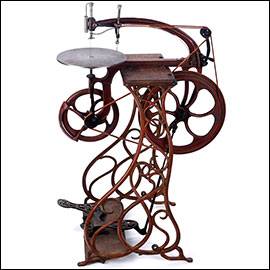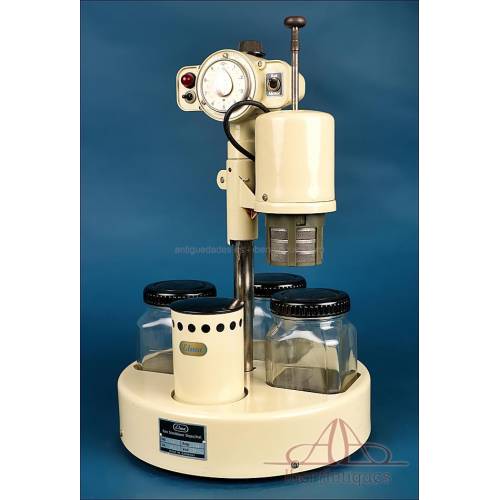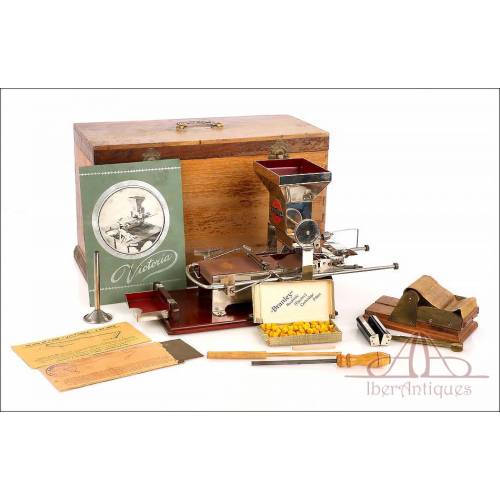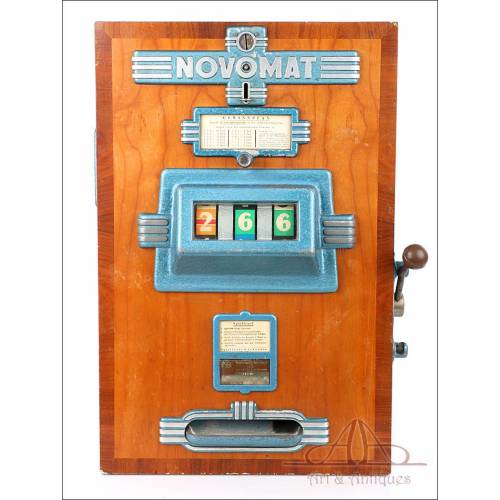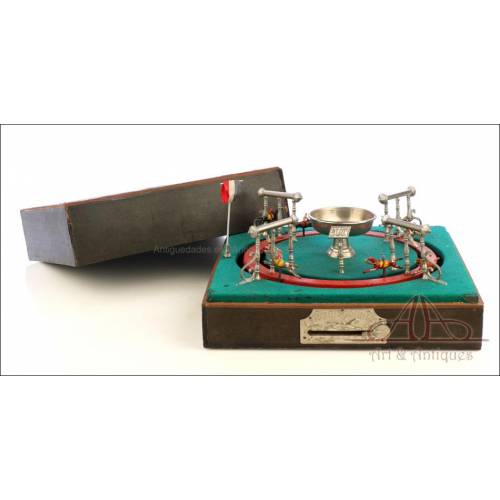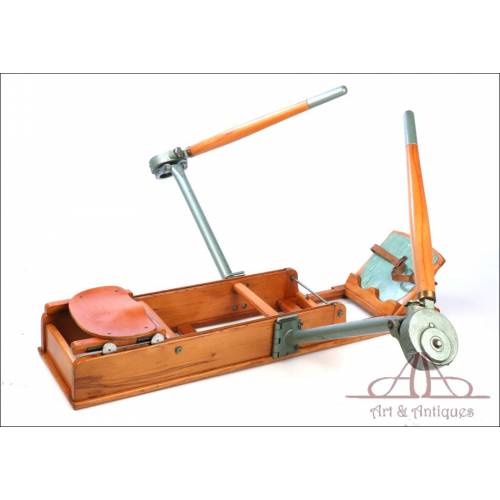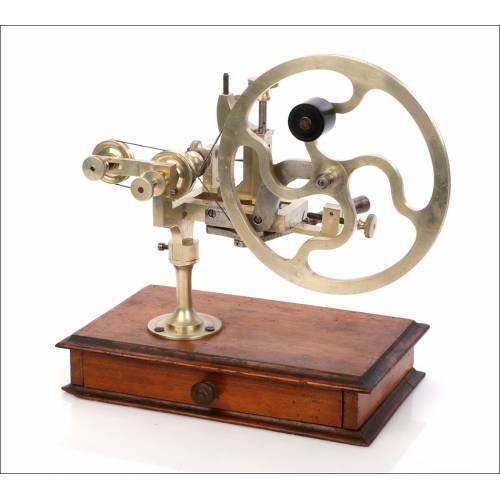Other Mechanical Antiques
Mechanical antiques are highly sought after and valued for their beautiful aesthetics and ingenious mechanisms. In addition to classic pieces including typewriters, calculators or clocks, there are other antique mechanically operated devices that stand out in the best collections or as part of the decor. The machines in kitchens of all times are...
Mechanical antiques are highly sought after and valued for their beautiful aesthetics and ingenious mechanisms. In addition to classic pieces including typewriters, calculators or clocks, there are other antique mechanically operated devices that stand out in the best collections or as part of the decor. The machines in kitchens of all times are a good example: in the days when there was no electricity, many tasks (such as washing clothes or grinding and chopping food) had to be done by hand. To lighten the work, ingenious gadgets were invented to make them quicker and easier.
And what to say about the wonderful old sewing machines... Its mechanism allowed to sew garments of resistant form and with very regular stitches, to the point that at the present time there are many experts who think that these machines sew better than the modern electronic models. These mechanical antiques are joined by other curious devices such as cigarette rolling machines, mechanical washing machines or mincers and sausage fillers. All of them are fantastic period pieces worthy of admiration, both for the ingenuity shown by their inventors and for their wonderful antique aesthetics.
Sewing machines. They are the most popular mechanical antiques, along with typewriters and calculators. Many people remember watching their mothers, grandmothers or aunts sewing with a Singer, Alpha or Sigma machine, while operating a treadle that spun the wheel at full speed. In fact, some people continue to use them because of the quality of their seams. The first to appear on the market were the German Singer machines (around 1912), which stood out for their smooth operation and beauty. In Spain, the Sigma brand was a sales success as it had nothing to envy to its foreign competitors in terms of beauty or quality of workmanship.
Cigarette rolling machines. . These old-fashioned, mechanically operated machines were a real "hit" after their appearance in 1920. Their ingenious mechanism allowed cigarettes to be rolled quickly, cleanly and easily. In Spain, the most popular was undoubtedly the Victoria model, launched in the 1920s by the Victorero brothers' company. It had a water tank to wet the adhesive side of the paper, a hopper for the tobacco, a crank and a conveyor belt. Today, vintage cigarette rolling machines are highly prized pieces, especially if they are complete and in working order.
Coffee grinders. For decades, in Spanish kitchens there was only one method for grinding coffee beans: doing so in the classic manual grinders, consisting of a wooden box with a hand-crank mechanism. The coffee beans were placed in the upper metallic deposit; when the crank was cranked, the blades ground the beans and the coffee powder was deposited in the lower drawer. In the 1960s, electric grinders replaced these nostalgic devices. Today they are pieces with charm and character, perfect for decorating rustic-style kitchens.
Bread slicing machines. These machines are quite rare pieces. Many of those preserved today are of Italian provenance and consist of a support for the loaf of bread (formed by two boards joined at right angles and placed in V) and a blade with a crank. Its operation is simple: just turn the crank and push the loaf of bread to cut the slices.
Picers and stuffers. These are also classic machines of old kitchens, especially mincers. They are cast iron grinders that were fixed to the tables by means of a vice. Their function was to mince meat, especially for the production of sausages. Sausage stuffers, on the other hand, have a hopper for placing the minced meat and a cylindrical mechanism used to press it into the casing, thus making the sausage.
Old washing machines . Washing machines were another ingenuity designed to make household chores more bearable. The best-known models consisted of a barrel-shaped drum with blades inside, which were turned by a large wheel and pulley mechanism. Clothes were put into the drum along with water and soap. Some washing machines included a drying system consisting of two parallel cylinders with a crank, similar to those used in pasta machines. The first electric washing machines appeared in Europe in 1915, but they would not become popular until the 1960s.
The world of mechanical antiques is as fascinating as it is attractive. Collecting such pieces can become a real passion, perfect for lovers of ingenious gadgets with personality.
Vintage Elma Machine for Cleaning Watch Movements, Germany, c. 1960 Vintage Elma Machine for...
Elma watch movement cleaner, Germany, 1960. Complete and functional, with original jars and mini baskets. Operates at 125V. Elma watch movement cleaner, Germany,...
SoldAntique Victoria Cigarette Rolling Machine, Spain c.1920 Antique Victoria Cigarette...
Automatic "Victoria" cigarette rolling machine, made in Spain around 1920. Includes original box and all accessories in excellent condition. Ideal for tobacco item collectors. Automatic "Victoria" cigarette...
SoldAntique Novomat Slot Machine. 100% mechanical. Germany, 1957 Antique Novomat Slot Machine....
Fabulous antique Novomat slot machine in fine condition. In perfect working order. Very decorative. Fabulous antique Novomat slot machine...
SoldAntique French horse racing betting game. France, Circa 1900 Antique French horse racing...
Amazing antique horse racing betting game. Complete and in perfect working order. Collectors piece. Amazing antique horse racing betting...
SoldAntique Italian Lamborghini Rowing Machine. Italy, 1940s Antique Italian Lamborghini...
Wonderful Lamborghini rowing machine. Original from the 1940s. In very good condition and Wonderful Lamborghini rowing machine....
SoldAntique Clock Maker's Pulling Machine. Complete. Nineteenth Century Antique Clock Maker's Pulling...
Fascinating antique antique watch making machine. In superb condition and ready to use. Beautiful design, very decorative. Fascinating antique antique watch...
Sold
New products
-

Antique ivory and silver plated stethoscope, late 19th century
Antique stethoscope from the late 19th century in silver-plated metal...
-

Vintage pendant with shell cameo of Jesús del Gran Poder, carved c. 1970
Vintage pendant with a shell-carved cameo of Jesus del Gran Poder, circa...
-

Antique Roman Style Gilded Silver Chalice with Paten. France, 1932
Antique Roman-style chalice in gilded silver with paten. France, 1932....
-

Beautiful Antique 18 K Gold Ring with 7 Natural Diamonds
Antique 18K gold ring with 7 natural diamonds. Delicate openwork design,...
-

Antique Silver Reliquary. José Vilaplana. Valencia, Spain. Circa 1920
Impressive repoussé silver reliquary by José Vilaplana, Valencia, c....
-

Vintage 18K Gold Ring with 7 Natural Diamonds
Vintage 18K gold ring with seven natural diamonds in floral setting....
-

Antique Silver Chalice. Enameled Crosses. Valencia, Spain, 1942
Spanish chalice from 1942 in solid silver, gifted by the Church of...
-

Antique Silver Chalice and Paten. Granada Spain, circa 1900
Spanish chalice in white silver with matching paten, handcrafted....
Specials
-

Exquisite Antique 19th Century French Porcelain Figurine: 'Amour Conjugal'
Charming French porcelain figurine...

